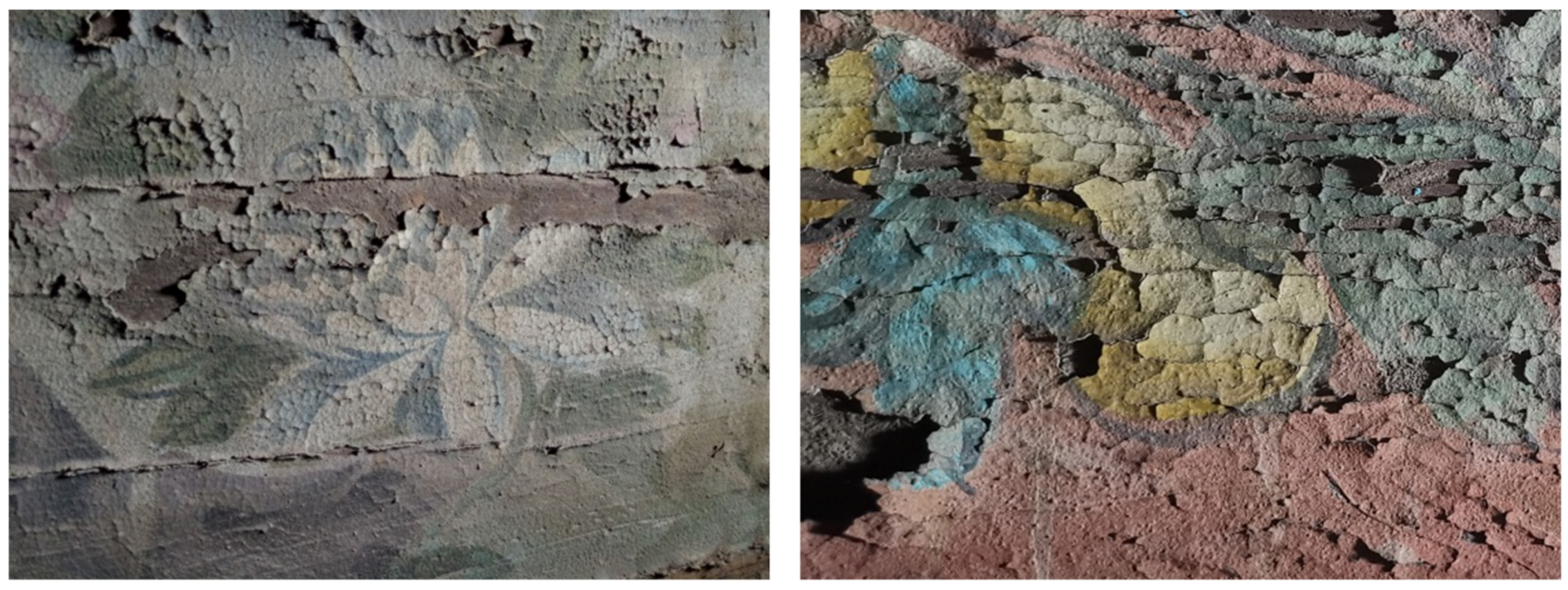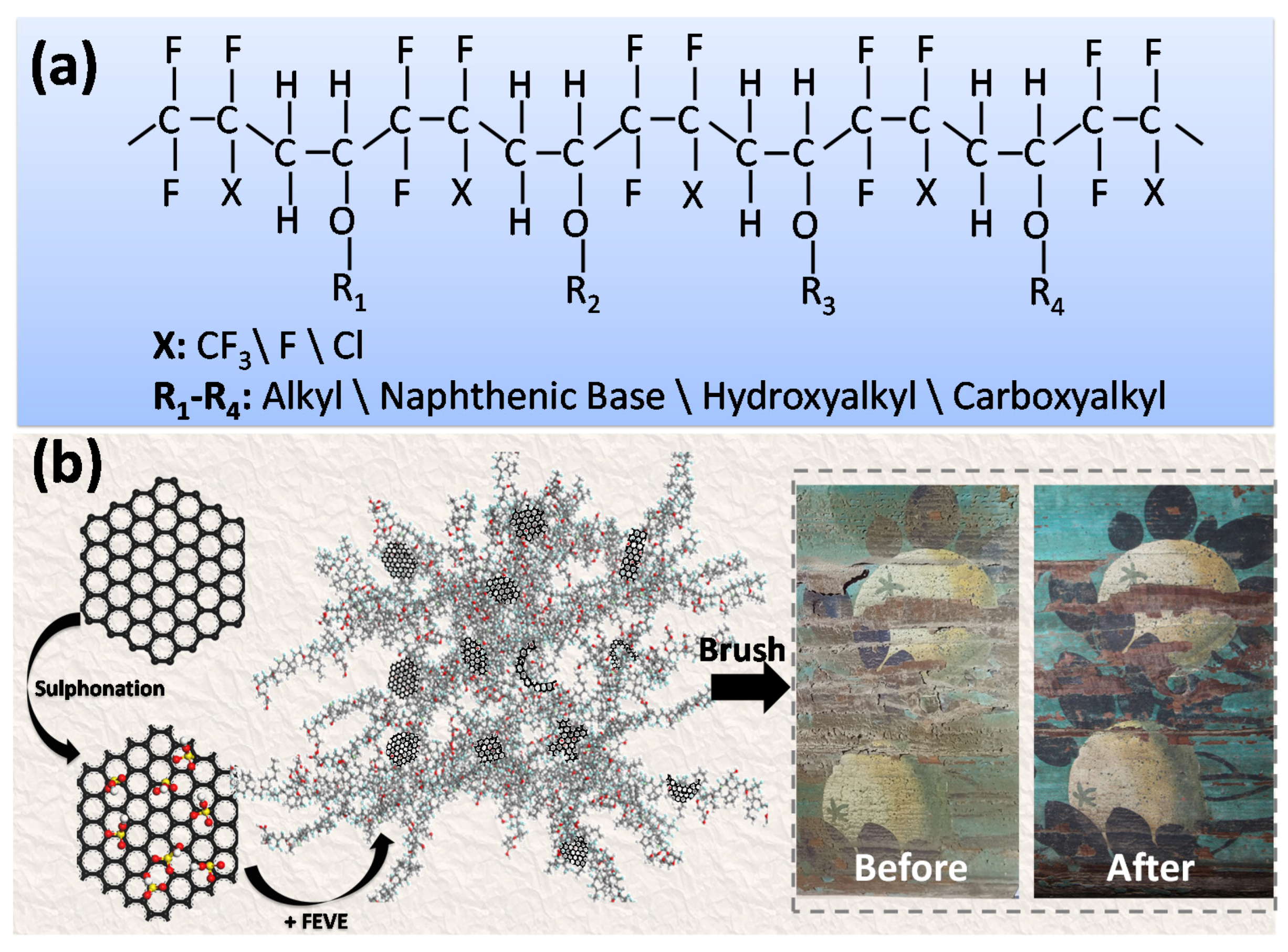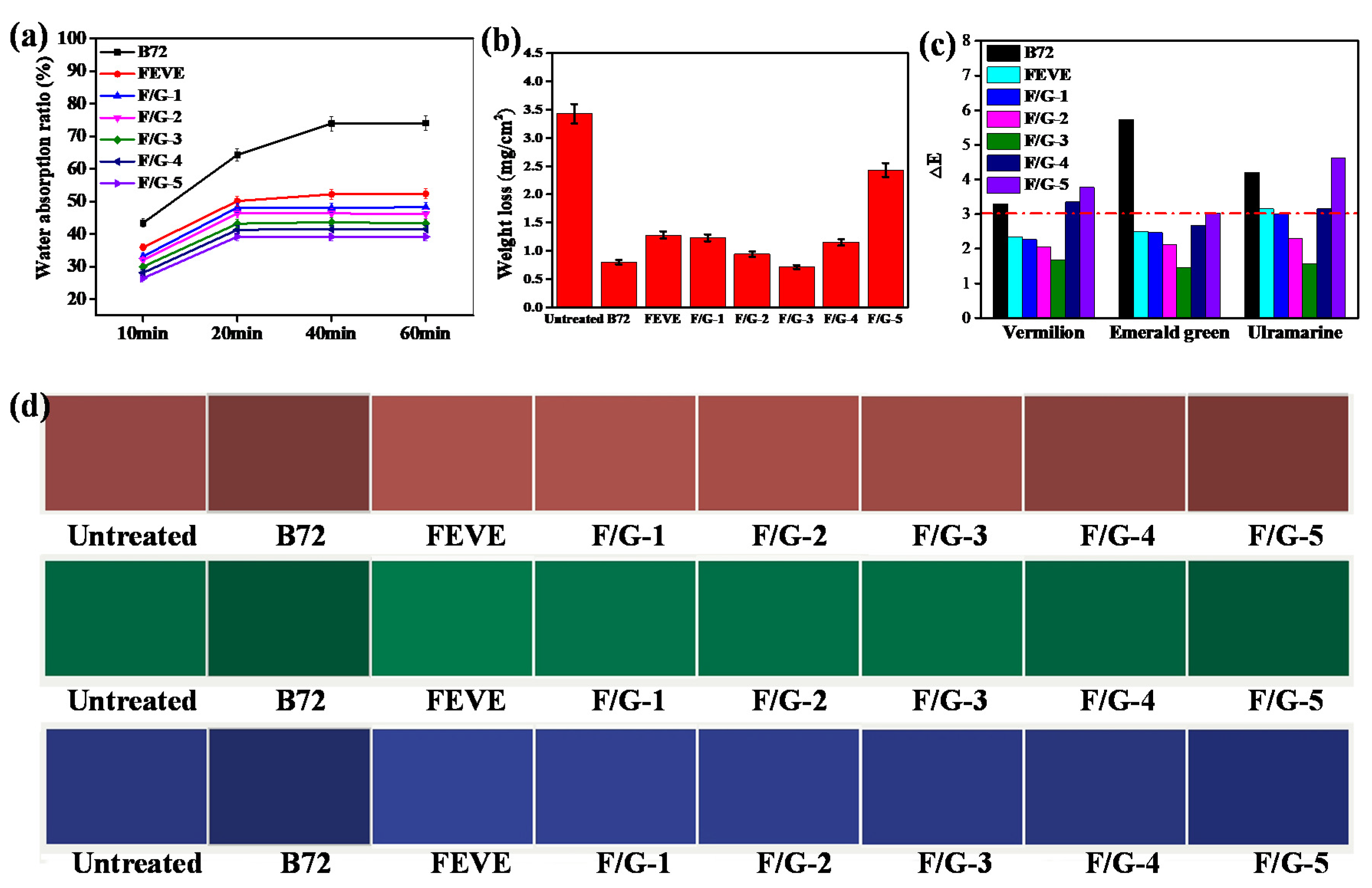Modified Graphene-FEVE Composite Coatings: Application in the Repair of Ancient Architectural Color Paintings
Abstract
1. Introduction
2. Materials and Experiment
2.1. Chemicals and Apparatus
2.2. Preparation of the Materials
2.3. Methods Used to Test the Properties of the Film
2.4. Performance of Coatings Applied to the Samples Simulating Mortar
2.4.1. Water Absorption Test of the Samples
2.4.2. Testing the Mechanical Properties of the Samples
2.4.3. Aging Resistance Test
Salt Resistance Test
- (a)
- Hygroscopic salt/pigment/consolidant system (hygroscopic salt itself exists in the sample): Vermilion, ultramarine, and emerald green pigments were mixed with 5% hygroscopic salt (Na2SO4) and a bone glue solution and were then brushed onto the simulated mortar. Finally, the reinforcement coating was applied, and the samples were kept at room temperature for 24 h. All samples were put into a freeze–thaw cycle box, the freeze–thaw aging is set at 24 h cycle and −40 °C–40 °C is divided into 4 stages. Replacement every 6 h, e.g., −40 °C to −20 °C, takes 6 h. This experiment completed a cycle in 24 h, with 60 cycles equal to 60 days. The humidity was maintained at 50%, and the STT test was conducted every 15 days.
- (b)
- Pigment/consolidant/hygroscopic salt system (hygroscopic salt from the outside): Bone glue was mixed with three kinds of pigments, and brushed onto the simulated mortar, and then kept at room temperature for 24 h. Ten milliliters of a 5% sodium sulfate solution was poured into a culture dish, and the absorbent stone was then placed in the culture dish. The strengthened sample pigment layer was placed facing downward onto the absorbent stone and immersed for 3 h. After removal, the sample was put into a freeze–thaw circulation box, with the temperature set to −40 °C–40 °C, humidity at 50%, for 60 days, and the STT test was conducted every 15 days.
UV Aging Test
Color Difference Test of the Samples
3. Results and Discussion
3.1. Structural Characterization of FEVE/m-GO
3.2. Properties of the Films
3.3. Application of Coatings to the Samples
4. Conclusions
Supplementary Materials
Author Contributions
Funding
Acknowledgments
Conflicts of Interest
References
- Ma, Z.; Wang, L.; Yan, J.; Zhou, W.; Pitthard, V.; Bayerova, T.; Krist, G. Chromatographic, Microscopic, and Spectroscopic Characterization of a Wooden Architectural Painting from the Summer Palace, Beijing, China. Anal. Lett. 2019, 52, 1670–1680. [Google Scholar] [CrossRef]
- Zhu, T.; Li, T.; Liu, N.; Chen, J.; Huang, H.; Fu, Q.; Zhang, S. Hexi painting on Xitian Fanjing, a Qing imperial Buddhist temple in Beijing, China: Technology revealed by analytical approaches (an initial report). Herit. Sci. 2016, 4, 50. [Google Scholar] [CrossRef]
- Shen, A.G.; Wang, X.H.; Xie, W.; Shen, J.; Li, H.Y.; Liu, Z.A.; Hu, J.-M. Pigment identification of colored drawings from Wuying Hall of the Imperial Palace by micro-Raman spectroscopy and energy dispersive X-ray spectroscopy. J. Raman Spectrosc. 2006, 37, 230–234. [Google Scholar] [CrossRef]
- Fu, P.; Teri, G.; Li, J.; Huo, Y.; Yang, H.; Li, Y.-H. Analysis of an Ancient Architectural Painting from the Jiangxue Palace in the Imperial Museum, Beijing, China. Anal. Lett. 2020, 1–14. [Google Scholar] [CrossRef]
- Wang, N.; He, L.; Zhao, X.; Simon, S. Comparative analysis of eastern and western drying-oil binding media used in polychromic artworks by pyrolysis–gas chromatography/mass spectrometry under the influence of pigments. Microchem. J. 2015, 123, 201–210. [Google Scholar] [CrossRef]
- Fu, P.; Teri, G.-L.; Li, J.; Li, J.-X.; Li, Y.-H.; Yang, H. Investigation of Ancient Architectural Painting from the Taidong Tomb in the Western Qing Tombs, Hebei, China. Coatings 2020, 10, 688. [Google Scholar] [CrossRef]
- Qin, P.; Yi, D.; Meng, Q.; Sun, A.; Sun, J.; Zhang, Z.; Hao, J. Study and Restoration of the Yi Ma Wu Hui Layer of the Ancient Coating on the Putuo Zongcheng Temple. Int. J. Arch. Herit. 2020. [Google Scholar] [CrossRef]
- Schifano, E.; Cavallini, D.; De Bellis, G.; Bracciale, M.P.; Felici, A.C.; Santarelli, M.L.; Sarto, M.S.; Uccelletti, D. Antibacterial Effect of Zinc Oxide-Based Nanomaterials on Environmental Biodeteriogens Affecting Historical Buildings. Nanomaterials 2020, 10, 335. [Google Scholar] [CrossRef]
- Murray, A. Materials for conservation: Organic consolidants, adhesives and coatings. Stud. Conserv. 2013, 58, 58–59. [Google Scholar] [CrossRef]
- Artesani, A.; Di Turo, F.; Zucchelli, M.; Traviglia, A. Recent Advances in Protective Coatings for Cultural Heritage—An Overview. Coatings 2020, 10, 217. [Google Scholar] [CrossRef]
- Baglioni, M.; Rengstl, D.; Berti, D.; Bonini, M.; Giorgi, R.; Baglioni, P. Removal of acrylic coatings from works of art by means of nanofluids: Understanding the mechanism at the nanoscale. Nanoscale 2010, 2, 1723–1732. [Google Scholar] [CrossRef] [PubMed]
- Chelazzi, D.; Poggi, G.; Jaidar, Y.; Toccafondi, N.; Giorgi, R.; Baglioni, P. Hydroxide nanoparticles for cultural heritage: Consolidation and protection of wall paintings and carbonate materials. J. Colloid Interface Sci. 2013, 392, 42–49. [Google Scholar] [CrossRef] [PubMed]
- Carretti, E.; Dei, L. Physicochemical characterization of acrylic polymeric resins coating porous materials of artistic interest. Prog. Org. Coat. 2004, 49, 282–289. [Google Scholar] [CrossRef]
- Unoki, M.; Kimura, I.; Yamauchi, M. Solvent-soluble fluoropolymers for coatings—Chemical structure and weatherability. Surf. Coat. Int. Part B Coat. Trans. 2002, 85, 209–213. [Google Scholar] [CrossRef]
- Zhong, B.; Shen, L.; Zhang, X.; Li, C.; Bao, N. Reduced graphene oxide/silica nanocomposite-reinforced anticorrosive fluorocarbon coating. J. Appl. Polym. Sci. 2020, 138. [Google Scholar] [CrossRef]
- Sumi, N.; Kimura, I.; Ataku, M.; Maekawa, T.; Parker, R. New advances in waterborne fluoropolymer technology: A water-based dispersion for industrial coatings formulations. JCT Coat. 2009, 6, 24–28. [Google Scholar]
- Takayanagi, T.; Yamabe, M. Progress of fluoropolymers on coating applications—Development of mineral spirit soluble polymer and aqueous dispersion. Prog. Org. Coat. 2000, 40, 185–190. [Google Scholar] [CrossRef]
- Ollik, K.; Lieder, M. Review of the Application of Graphene-Based Coatings as Anticorrosion Layers. Coatings 2020, 10, 883. [Google Scholar] [CrossRef]
- Zhu, J.; Li, X.; Zhang, Y.; Wang, J.; Wei, B. Graphene-enhanced nanomaterials for wall painting protection. Adv. Funct. Mater. 2018, 28, 1803872. [Google Scholar] [CrossRef]
- Inagaki, M.; Kang, F. Graphene derivatives: Graphane, fluorographene, graphene oxide, graphyne and graphdiyne. J. Mater. Chem. A 2014, 2, 13193–13206. [Google Scholar] [CrossRef]
- Wang, P.; Yao, T.; Sun, B.; Fan, X.; Dong, S.; Bai, Y.; Shi, Y. A cost-effective method for preparing mechanically stable anti-corrosive superhydrophobic coating based on electrochemically exfoliated graphene. Colloids Surf. A Physicochem. Eng. Asp. 2017, 513, 396–401. [Google Scholar] [CrossRef]
- Sahu, S.C.; Samantara, A.K.; Seth, M.; Parwaiz, S.; Singh, B.P.; Rath, P.C.; Jena, B.K. A facile electrochemical approach for development of highly corrosion protective coatings using graphene nanosheets. Electrochem. Commun. 2013, 32, 22–26. [Google Scholar] [CrossRef]
- Dong, Y.; Liu, Q.; Zhou, Q. Corrosion behavior of Cu during graphene growth by CVD. Corros. Sci. 2014, 89, 214–219. [Google Scholar] [CrossRef]
- Gong, Y.; Shen, L.; Kang, Z.; Liu, K.; Du, Q.; Ye, D.; Zhao, H.; Sun, X.A.; Zhang, J. Progress in energy-related graphyne-based materials: Advanced synthesis, functional mechanisms and applications. J. Mater. Chem. A 2020, 8, 21408–21433. [Google Scholar] [CrossRef]
- Makvandi, P.; Ghomi, M.; Ashrafizadeh, M.; Tafazoli, A.; Agarwal, T.; Delfi, M.; Akhtari, J.; Zare, E.N.; Padil, V.V.T.; Zarrabi, A.; et al. A review on advances in graphene-derivative/polysaccharide bionanocomposites: Therapeutics, pharmacogenomics and toxicity. Carbohydr. Polym. 2020, 250, 116952. [Google Scholar] [CrossRef]
- Georgakilas, V.; Tiwari, J.N.; Kemp, K.C.; Perman, J.A.; Bourlinos, A.B.; Kim, K.S.; Zboril, R. Noncovalent Functionalization of Graphene and Graphene Oxide for Energy Materials, Biosensing, Catalytic, and Biomedical Applications. Chem. Rev. 2016, 116, 5464–5519. [Google Scholar] [CrossRef]
- Ma, K.; Wang, R.; Jiao, T.; Zhou, J.; Zhang, L.; Li, J.; Bai, Z.; Peng, Q. Preparation and aggregate state regulation of co-assembly graphene oxide-porphyrin composite Langmuir films via surface-modified graphene oxide sheets. Colloids Surf. A Physicochem. Eng. Asp. 2020, 584. [Google Scholar] [CrossRef]
- ISO 15184 Paints and Varnishes-Determination of Film Hardness by Pencil Test 2012; International Organization for Standardization: Geneva, Switzerland, 2012.
- Zhang, Y.; Li, X.; Zhu, J.; Wang, S.; Wei, B. Hybrids of CNTs and acrylic emulsion for the consolidation of wall paintings. Prog. Org. Coat. 2018, 124, 185–192. [Google Scholar] [CrossRef]
- Bourguignon, E.; Tomasin, P.; Detalle, V.; Vallet, J.-M.; Labouré, M.; Olteanu, I.; Favaro, M.; Chiurato, M.A.; Bernardi, A.; Becherini, F. Calcium alkoxides as alternative consolidants for wall paintings: Evaluation of their performance in laboratory and on site, on model and original samples, in comparison to conventional products. J. Cult. Herit. 2018, 29, 54–66. [Google Scholar] [CrossRef]
- Ibrahim, M.M.; Mohamed, S.O.; Hefni, Y.K.; Ahmed, A.I. Nanomaterials for Consolidation and Protection of Egyptian Faience Form Matteria, Egypt. J. Nano Res. 2019, 56, 39–48. [Google Scholar] [CrossRef]
- O’Connell, M.J.; Boul, P.; Ericson, L.M.; Huffman, C.; Wang, Y.H.; Haroz, E.; Kuper, C.; Tour, J.; Ausman, K.D.; Smalley, R.E. Reversible water-solubilization of single-walled carbon nanotubes by polymer wrapping. Chem. Phys. Lett. 2001, 342, 265–271. [Google Scholar] [CrossRef]
- Zhou, X. Preparation of Poly(Sodium 4-Styrenesulfonate) Grafted Carbon Black Via Ultrasonic Irradiation Initiated Radical Polymerization. Acta Polym. Sin. 2008, 8, 366–370. [Google Scholar] [CrossRef]
- Coşkun, E.; Zaragoza-Contreras, E.A.; Salavagione, H.J. Synthesis of sulfonated graphene/polyaniline composites with improved electroactivity. Carbon 2012, 50, 2235–2243. [Google Scholar] [CrossRef]
- Maiti, S.; Kundu, S.; Mondal, S.; Roy, C.N.; Ghosh, D.; Saha, A. Synthesis and spectral measurements of sulphonated graphene: Some anomalous observations. Phys. Chem. Chem. Phys. 2016, 18, 6701–6705. [Google Scholar] [CrossRef] [PubMed]
- Lin, Z.; Cheng, Y.; Lue, H.; Zhang, L.; Yang, B. Preparation and characterization of novel ZnS/sulfur-containing polymer nanocomposite optical materials with high refractive index and high nanophase contents. Polymer 2010, 51, 5424–5431. [Google Scholar] [CrossRef]
- Xu, L.; Geng, Z.; He, J.; Zhou, G. Mechanically Robust, Thermally Stable, Broadband Antireflective, and Superhydrophobic Thin Films on Glass Substrates. ACS Appl. Mater. Interfaces 2014, 6, 9029–9035. [Google Scholar] [CrossRef]
- Zhang, Y.; Li, X.; Wei, B. Environment-Friendly Poly(2-ethyl-2-oxazoline) as an Innovative Consolidant for Ancient Wall Paintings. Nanomaterials 2018, 8, 649. [Google Scholar] [CrossRef]
- Rodrigues, J.D.; Grossi, A. Indicators and ratings for the compatibility assessment of conservation actions. J. Cult. Herit. 2007, 8, 32–43. [Google Scholar] [CrossRef]







| Sample | Pencil Hardness | Tensile Lap-Shear Strength (MPa) | |
|---|---|---|---|
| Before Aging | After Aging | ||
| B72 | HB | 4.5291 | 3.9168 |
| FEVE | H | 4.3139 | 4.1673 |
| F/G-1 | H | 4.5636 | 4.5796 |
| F/G-2 | 2H | 4.7319 | 4.7382 |
| F/G-3 | 2H | 4.8422 | 4.8514 |
| F/G-4 | 3H | 4.7918 | 4.7619 |
| F/G-5 | 4H | 4.7483 | 4.7361 |
Publisher’s Note: MDPI stays neutral with regard to jurisdictional claims in published maps and institutional affiliations. |
© 2020 by the authors. Licensee MDPI, Basel, Switzerland. This article is an open access article distributed under the terms and conditions of the Creative Commons Attribution (CC BY) license (http://creativecommons.org/licenses/by/4.0/).
Share and Cite
Fu, P.; Teri, G.-L.; Chao, X.-L.; Li, J.; Li, Y.-H.; Yang, H. Modified Graphene-FEVE Composite Coatings: Application in the Repair of Ancient Architectural Color Paintings. Coatings 2020, 10, 1162. https://doi.org/10.3390/coatings10121162
Fu P, Teri G-L, Chao X-L, Li J, Li Y-H, Yang H. Modified Graphene-FEVE Composite Coatings: Application in the Repair of Ancient Architectural Color Paintings. Coatings. 2020; 10(12):1162. https://doi.org/10.3390/coatings10121162
Chicago/Turabian StyleFu, Peng, Ge-Le Teri, Xiao-Lian Chao, Jing Li, Yu-Hu Li, and Hong Yang. 2020. "Modified Graphene-FEVE Composite Coatings: Application in the Repair of Ancient Architectural Color Paintings" Coatings 10, no. 12: 1162. https://doi.org/10.3390/coatings10121162
APA StyleFu, P., Teri, G.-L., Chao, X.-L., Li, J., Li, Y.-H., & Yang, H. (2020). Modified Graphene-FEVE Composite Coatings: Application in the Repair of Ancient Architectural Color Paintings. Coatings, 10(12), 1162. https://doi.org/10.3390/coatings10121162





